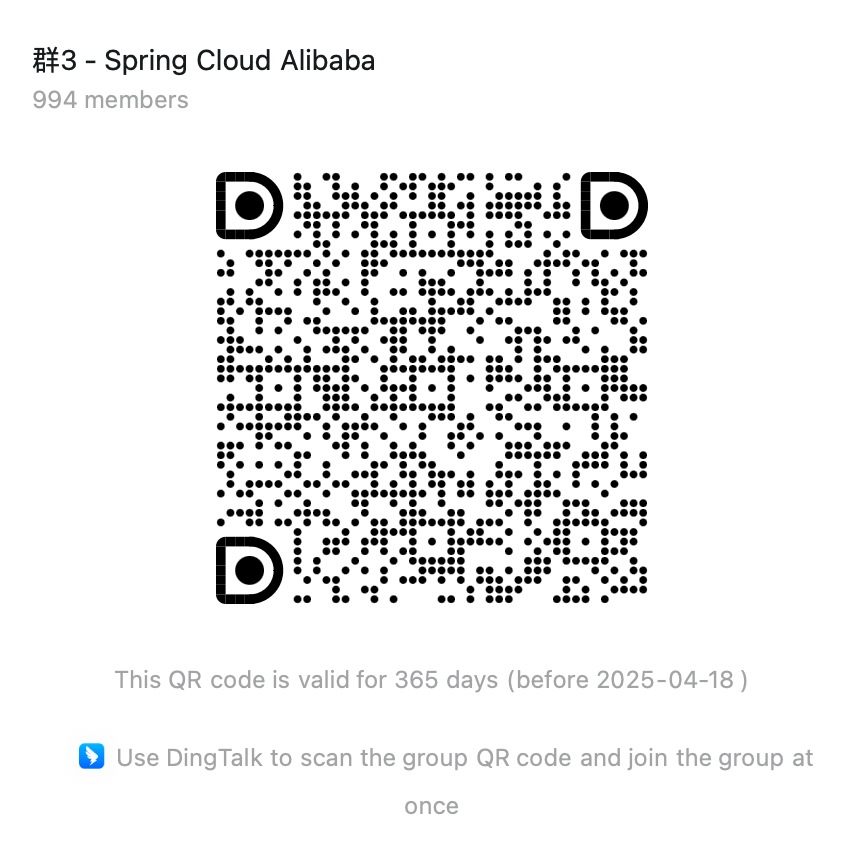Quick Start
Quick Start
This section demonstrates how to use the spring-cloud-starter-alibaba-governance-routing module to complete the routing capacity.
Component support description
Currently, the routing module only supports some components:
Remote call Component: Spring Cloud OpenFeign
Load balance Component: Ribbon
In the future, more components such as RestTemplate, Spring Cloud LoadBalancer and so on will be supported.
Example
How to access
Note that this section is only for your convenience in understanding the access method. The access work has been completed in this sample code, and you do not need to modify it.
- First, modify the pom XML file, which introduces the
spring-cloud-starter-alibaba-governance-routingdependency.
<dependency> <groupId>com.alibaba.cloud</groupId> <artifactId>spring-cloud-starter-alibaba-governance-routing</artifactId></dependency>2.Configure a load balance algorithm when there are no routing rules (RandomRule algorithm as an example) If no configuration,use default ribbon load balance algorithm ZoneAvoidanceRule.
spring.cloud.governance.routing.rule=RandomRuleApplication Start
Start a startup class of three modules, ConsumerApplication and two ProviderApplications, and inject them into the Nacos registry.
Effect demonstration
Rule Description
The rules set in the instance are as follows:
@GetMapping("/add")public void getDataFromControlPlaneTest() { List<RouteRule> routeRules = new ArrayList<>(); List<MatchService> matchServices = new ArrayList<>(); UnifiedRouteDataStructure unifiedRouteDataStructure = new UntiedRouteDataStructure(); unifiedRouteDataStructure.setTargetService("service-provider"); LabelRouteRule labelRouteData = new LabelRouteRule(); labelRouteData.setDefaultRouteVersion("v1"); RouteRule routeRule = new HeaderRule(); routeRule.setType("header"); routeRule.setCondition("="); routeRule.setKey("tag"); routeRule.setValue("v2"); RouteRule routeRule1 = new UrlRule.Parameter(); routeRule1.setType("parameter"); routeRule1.setCondition(">"); routeRule1.setKey("id"); routeRule1.setValue("10"); RouteRule routeRule2 = new UrlRule.Path(); routeRule2.setType("path"); routeRule2.setCondition("="); routeRule2.setValue("/router-test"); routeRules.add(routeRule); routeRules.add(routeRule1); routeRules.add(routeRule2); MatchService matchService = new MatchService(); matchService.setVersion("v2"); matchService.setWeight(100); matchService.setRuleList(routeRules); matchServices.add(matchService); labelRouteData.setMatchRouteList(matchServices); unifiedRouteDataStructure.setLabelRouteRule(labelRouteData); List<UntiedRouteDataStructure> unifiedRouteDataStructureList = new ArrayList<>(); unifiedRouteDataStructureList.add(unifiedRouteDataStructure); controlPlaneConnection.pushRouteData(unifiedRouteDataStructureList);}The rules corresponding to the code are as follows:
If the request parameter contains tag=v2 and the request header contains id and the value is greater than 10, uri is /router-test at the same time, the traffic is routed to the v2 version. If one of the request parameters does not meet the requirement, the traffic is routed to the v1 version.
Rules also support dynamic modification. The rules for testing dynamic modification are as follows:
@GetMapping("/add")public void getDataFromControlPlaneTest() { List<RouteRule> routeRules = new ArrayList<>(); List<MatchService> matchServices = new ArrayList<>(); UntiedRouteDataStructure unifiedRouteDataStructure = new UntiedRouteDataStructure(); unifiedRouteDataStructure.setTargetService("service-provider"); LabelRouteRule labelRouteData = new LabelRouteRule(); labelRouteData.setDefaultRouteVersion("v1");
RouteRule routeRule = new HeaderRule(); routeRule.setType("header"); routeRule.setCondition("="); routeRule.setKey("tag"); routeRule.setValue("v2"); RouteRule routeRule1 = new UrlRule.Parameter(); routeRule1.setType("parameter"); routeRule1.setCondition(">"); routeRule1.setKey("id"); routeRule1.setValue("10");
RouteRule routeRule2 = new UrlRule.Path(); routeRule2.setType("path"); routeRule2.setCondition("="); routeRule2.setValue("/router-test"); routeRules.add(routeRule); routeRules.add(routeRule1); routeRules.add(routeRule2);
MatchService matchService = new MatchService(); matchService.setVersion("v2"); matchService.setWeight(50); matchService.setRuleList(routeRules); matchServices.add(matchService); labelRouteData.setMatchRouteList(matchServices); unifiedRouteDataStructure.setLabelRouteRule(labelRouteData); List<UntiedRouteDataStructure> unifiedRouteDataStructureList = new ArrayList<>(); unifiedRouteDataStructureList.add(unifiedRouteDataStructure); controlPlaneConnection.pushRouteData(unifiedRouteDataStructureList);}The rules corresponding to the code are as follows:
If the request parameter contains tag=v2, and the request header contains id and the value is greater than 10, URL is /router-test, 50% of the traffic is routed to the v2 version, and the rest is routed to the v1 version. If one of the traffic does not meet the requirements, the traffic is routed to the v1 version.
demonstration Steps
-
visit http://localhost:18083/add Push the routing rules from the control surface interface to the routing rule warehouse visit http://localhost:18083/router -The test does not meet the routing rules. When the test is routed to the v1 version, the v1 version instance prints and returns the following results:
Route in 30.221.132.228: 18081,version is v1.visit http://localhost:18083/router-test?id=11 and the key-tag which value set in the request header is v2, which meets the routing rules. The route is to the v2 version. The v2 version instance prints and returns the following results:
Route in 30.221.132.228: 18082,version is v2. -
visit http://localhost:18083/update Simulate dynamic modification of routing rules. visit http://localhost:18083/router The test does not meet the routing rules. When the test is routed to the v1 version, the v1 version instance prints and returns the following results:
Route in 30.221.132.228: 18081,version is v1.visit http://localhost:18083/router-test?id=11 and the key-tag which value set in the request header is v2, which meets the routing rules. 50% of the routes are routed to the v2 version. The v2 version instance prints the following results:
Route in 30.221.132.228: 18082,version is v2.50% of them are routed to the v1 version, and the following results are returned when the v1 version instance is printed:
Route in 30.221.132.228: 18081,version is v1. -
If you don’t push rule,it will load balance by common rule you set.
Integrating Istio
Note that this section is only for your convenience in understanding the access method. The access work has been completed in this sample code, and you do not need to modify it.
Preparation
Install K8s
Please refer to tools chapter of K8s document.
Enable Istio on K8s
Please refer to install chapter of Istio document.
Introduction to Istio traffic control rules
- First, modify the pom.xml file to introduce the
spring-cloud-starter-alibaba-governance-routingandspring-cloud-starter-xds-adapterdependency
<dependency> <groupId>com.alibaba.cloud</groupId> <artifactId>spring-cloud-starter-alibaba-governance-routing</artifactId></dependency><dependency> <groupId>com.alibaba.cloud</groupId> <artifactId>spring-cloud-starter-xds-adapter</artifactId></dependency>- Configure application.yml for Istio control plane:
server: port: 18084spring: main: allow-bean-definition-overriding: true application: name: service-consumer cloud: nacos: discovery: server-addr: 127.0.0.1:8848 fail-fast: true username: nacos password: nacos governance: auth: # Is authentication enabled enabled: ${ISTIO_AUTH_ENABLE:false} istio: config: # Is Istio resource transform enabled enabled: ${ISTIO_CONFIG_ENABLE:true} # Istiod ip host: ${ISTIOD_ADDR:127.0.0.1} # Istiod port port: ${ISTIOD_PORT:15010} # Istiod thread-pool size polling-pool-size: ${POLLING_POOL_SIZE:10} # Istiod polling gap polling-time: ${POLLING_TIME:10} # Istiod token(For Istio 15012 port) istiod-token: ${ISTIOD_TOKEN:} # Whether to print xds log log-xds: ${LOG_XDS:true}Startup Application
Start IstioConsumerApplication and two ProviderApplications, and inject it into the Nacos registry center.
Publish Configuration
We publish the label routing rules through the Istio control plane. We publish a DestinationRule rule first:
kubectl apply -f - << EOFapiVersion: networking.istio.io/v1alpha3kind: DestinationRulemetadata: name: my-destination-rulespec: host: sca-virtual-service subsets: - name: v1 labels: version: v1 - name: v2 labels: version: v2EOFThis rule splits the back-end service into two versions. Pod with label v1 is assigned to v1, and pod with label v2 is assigned to v2 After that, we publish the VirtualService rule:
kubectl apply -f - << EOFapiVersion: networking.istio.io/v1alpha3kind: VirtualServicemetadata: name: sca-virtual-servicespec: hosts: - service-provider http: - match: - headers: tag: exact: v2 uri: exact: /istio-label-routing route: - destination: host: service-provider subset: v2 - route: - destination: host: service-provider subset: v1EOFThis VirtualService specifies the simplest label routing rule. HTTP requests with a v2 header and /istio-label-routing path are routed to v2, and the rest of the traffic is routed to v1:
Demonstration effect
We send an HTTP request without a request header to IstioConsumerApplication:
$ curl --location --request GET '127.0.0.1:18084/istio-label-routing'Since the request header is not v2, the request will be routed to version v1 with the following result:
Route in 30.221.132.228: 18081,version is v1.We then send an HTTP request with a v2 tag in its header and the request path is /istio-label-routing:
$ curl --location --request GET '127.0.0.1:18084/istio-label-routing' --header 'tag: v2'The request is routed to version v2 because the routing rule is matched by the request:
Route in 30.221.132.228: 18082,version is v2.Finally, we delete this label routing rule:
$ kubectl delete VirtualService sca-virtual-service$ kubectl delete DestinationRule my-destination-ruleAfter the rule is deleted, the routing policy is not determined by whether the request header is carried or not, but completely depends on the implementation of the loadbalancer.
Integrating OpenSergo
Note that this section is only for your convenience in understanding the access method. The access work has been completed in this sample code, and you do not need to modify it.
Configuration
- First, modify the
pom.xmlfile to introduce thespring-cloud-starter-alibaba-governance-routingandspring-cloud-starter-opensergo-adapterdependency
<dependency> <groupId>com.alibaba.cloud</groupId> <artifactId>spring-cloud-starter-alibaba-governance-routing</artifactId></dependency><dependency> <groupId>com.alibaba.cloud</groupId> <artifactId>spring-cloud-starter-opensergo-adapter</artifactId></dependency>- Configure
application.ymlfor OpenSergo control plane
# The endpoint of OpenSergo ControlPlanespring.cloud.opensergo.endpoint=127.0.0.1:10246Startup Application
Start OpenSergoConsumerApplication and two ProviderApplications, and inject it into the Nacos registry center.
Publish Configuration
First start OpenSergo control plan , Then we publish the label routing rules through the OpenSergo control plane. We publish a TrafficRouter rule.
kubectl apply -f - << EOFapiVersion: traffic.opensergo.io/v1alpha1kind: TrafficRoutermetadata: name: service-provider namespace: default labels: app: service-providerspec: hosts: - service-provider http: - match: - headers: tag: exact: v2 route: - destination: host: service-provider subset: v2 fallback: host: service-provider subset: v1 - route: - destination: host: service-provider subset: v1EOFThis TrafficRouter specifies the simplest label routing rule. HTTP requests with a v2 header are routed to v2, and the rest of the traffic is routed to v1. If the version v2 does not have a corresponding instance, the HTTP request will fall back to the version v1.
Demonstrate effect
We send an HTTP request without a request header to OpenSergoConsumerApplication
$ curl --location --request GET '127.0.0.1:18083/router-test'Since the request header is not v2, the request will be routed to version v1 with the following result
Route in 30.221.132.228: 18081,version is v1.We then send an HTTP request with a v2 tag in its header and the request path is /router-test:
$ curl --location --request GET '127.0.0.1:18083/router-test' --header 'tag: v2'The request is routed to version v2 because the routing rule is matched by the request.
Route in 30.221.132.228: 18082,version is v2.After we stop the ProviderApplication of the version v2, we send an HTTP request with the request header tag v2.
$ curl --location --request GET '127.0.0.1:18083/router-test' --header 'tag: v2'because the version v2 does not have a corresponding instance, so the Http requesr is fallback to the version v1.
Route in 30.221.132.228: 18081,version is v1.


